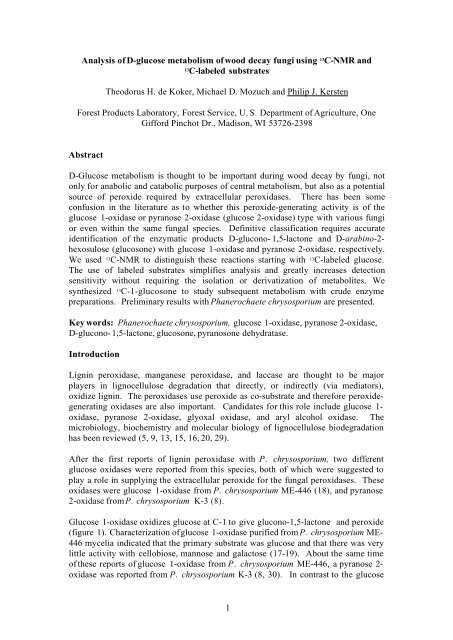View - Forest Products Laboratory
View - Forest Products Laboratory
View - Forest Products Laboratory
Create successful ePaper yourself
Turn your PDF publications into a flip-book with our unique Google optimized e-Paper software.
Analysis of D-glucose metabolism of wood decay fungi using 13 C-NMR and<br />
13<br />
C-labeled substrates<br />
Theodorus H. de Koker, Michael D. Mozuch and Philip J. Kersten<br />
<strong>Forest</strong> <strong>Products</strong> <strong>Laboratory</strong>, <strong>Forest</strong> Service, U. S. Department of Agriculture, One<br />
Gifford Pinchot Dr., Madison, WI 53726-2398<br />
Abstract<br />
D-Glucose metabolism is thought to be important during wood decay by fungi, not<br />
only for anabolic and catabolic purposes of central metabolism, but also as a potential<br />
source of peroxide required by extracellular peroxidases. There has been some<br />
confusion in the literature as to whether this peroxide-generating activity is of the<br />
glucose 1-oxidase or pyranose 2-oxidase (glucose 2-oxidase) type with various fungi<br />
or even within the same fungal species. Definitive classification requires accurate<br />
identification of the enzymatic products D-glucono- 1,5-lactone and D-arabino-2-<br />
hexosulose (glucosone) with glucose 1-oxidase and pyranose 2-oxidase, respectively.<br />
We used 13 C-NMR to distinguish these reactions starting with 13 C-labeled glucose.<br />
The use of labeled substrates simplifies analysis and greatly increases detection<br />
sensitivity without requiring the isolation or derivatization of metabolites. We<br />
synthesized 13 C-1-glucosone to study subsequent metabolism with crude enzyme<br />
preparations. Preliminary results with Phanerochaete chrysosporium are presented.<br />
Key words: Phanerochaete chrysosporium, glucose 1-oxidase, pyranose 2-oxidase,<br />
D-glucono- 1,5-lactone, glucosone, pyranosone dehydratase.<br />
Introduction<br />
Lignin peroxidase, manganese peroxidase, and laccase are thought to be major<br />
players in lignocellulose degradation that directly, or indirectly (via mediators),<br />
oxidize lignin. The peroxidases use peroxide as co-substrate and therefore peroxidegenerating<br />
oxidases are also important. Candidates for this role include glucose 1-<br />
oxidase, pyranose 2-oxidase, glyoxal oxidase, and aryl alcohol oxidase. The<br />
microbiology, biochemistry and molecular biology of lignocellulose biodegradation<br />
has been reviewed (5, 9, 13, 15, 16, 20, 29).<br />
After the first reports of lignin peroxidase with P. chrysosporium, two different<br />
glucose oxidases were reported from this species, both of which were suggested to<br />
play a role in supplying the extracellular peroxide for the fungal peroxidases. These<br />
oxidases were glucose 1-oxidase from P. chrysosporium ME-446 (18), and pyranose<br />
2-oxidase from P. chrysosporium K-3 (8).<br />
Glucose 1-oxidase oxidizes glucose at C-1 to give glucono-1,5-lactone and peroxide<br />
(figure 1). Characterization of glucose 1-oxidase purified from P. chrysosporium ME-<br />
446 mycelia indicated that the primary substrate was glucose and that there was very<br />
little activity with cellobiose, mannose and galactose (17-19). About the same time<br />
of these reports of glucose 1-oxidase from P. chrysosporium ME-446, a pyranose 2-<br />
oxidase was reported from P. chrysosporium K-3 (8, 30). In contrast to the glucose<br />
1
















